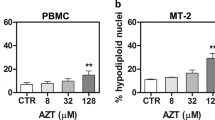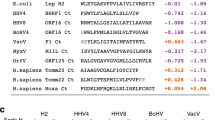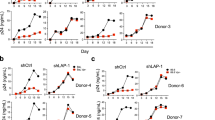Abstract
Adult T-cell leukemia (ATL) arises from a human T-cell leukemia virus type I (HTLV-I)-infected cell and has few therapeutic options. Here, we have uncovered a previously unrecognized role for a ubiquitin-editing enzyme A20 in the survival of HTLV-I-infected cells. Unlike in lymphomas of the B-cell lineage, A20 is abundantly expressed in primary ATL cells without notable mutations. Depletion of A20 in HTLV-I-infected cells resulted in caspase activation, cell death induction and impaired tumorigenicity in mouse xenograft models. Mechanistically, A20 stably interacts with caspase-8 and Fas-associated via death domain (FADD) in HTLV-I-infected cells. Mutational studies revealed that A20 supports the growth of HTLV-I-infected cells independent of its catalytic functions and that the zinc-finger domains are required for the interaction with and regulation of caspases. These results indicate a pivotal role for A20 in the survival of HTLV-I-infected cells and implicate A20 as a potential therapeutic target in ATL.
This is a preview of subscription content, access via your institution
Access options
Subscribe to this journal
Receive 12 print issues and online access
$259.00 per year
only $21.58 per issue
Buy this article
- Purchase on Springer Link
- Instant access to full article PDF
Prices may be subject to local taxes which are calculated during checkout








Similar content being viewed by others
References
Okamoto T, Ohno Y, Tsugane S, Watanabe S, Shimoyama M, Tajima K et al. Multi-step carcinogenesis model for adult T-cell leukemia. Jpn J Cancer Res 1989; 80: 191–195.
Hironaka N, Mochida K, Mori N, Maeda M, Yamamoto N, Yamaoka S . Tax-independent constitutive IkappaB kinase activation in adult T-cell leukemia cells. Neoplasia 2004; 6: 266–278.
Saitoh Y, Yamamoto N, Dewan MZ, Sugimoto H, Martinez Bruyn VJ, Iwasaki Y et al. Overexpressed NF-kappaB-inducing kinase contributes to the tumorigenesis of adult T-cell leukemia and Hodgkin Reed-Sternberg cells. Blood 2008; 111: 5118–5129.
Dixit VM, Green S, Sarma V, Holzman LB, Wolf FW, O'Rourke K et al. Tumor necrosis factor-alpha induction of novel gene products in human endothelial cells including a macrophage-specific chemotaxin. J Biol Chem 1990; 265: 2973–2978.
Opipari AW Jr, Hu HM, Yabkowitz R, Dixit VM . The A20 zinc finger protein protects cells from tumor necrosis factor cytotoxicity. J Biol Chem 1992; 267: 12424–12427.
Wertz IE, O'Rourke KM, Zhou H, Eby M, Aravind L, Seshagiri S et al. De-ubiquitination and ubiquitin ligase domains of A20 downregulate NF-kappaB signalling. Nature 2004; 430: 694–699.
Bosanac I, Wertz IE, Pan B, Yu C, Kusam S, Lam C et al. Ubiquitin binding to A20 ZnF4 is required for modulation of NF-κB signaling. Mol Cell 2010; 40: 548–557.
Shembade N, Ma A, Harhaj EW . Inhibition of NF-kappaB signaling by A20 through disruption of ubiquitin enzyme complexes. Science 2010; 327: 1135–1139.
Boone DL, Turer EE, Lee EG, Ahmad RC, Wheeler MT, Tsui C et al. The ubiquitin-modifying enzyme A20 is required for termination of Toll-like receptor responses. Nat Immunol 2004; 5: 1052–1060.
Mauro C, Pacifico F, Lavorgna A, Mellone S, Iannetti A, Acquaviva R et al. ABIN-1 binds to NEMO/IKKgamma and co-operates with A20 in inhibiting NF-kappaB. J Biol Chem 2006; 281: 18482–18488.
Hitotsumatsu O, Ahmad RC, Tavares R, Wang M, Philpott D, Turer EE et al. The ubiquitin-editing enzyme A20 restricts nucleotide-binding oligomerization domain containing 2-triggered signals. Immunity 2008; 28: 381–390.
Tokunaga F, Nishimasu H, Ishitani R, Goto E, Noguchi T, Mio K et al. Specific recognition of linear polyubiquitin by A20 zinc finger 7 is involved in NF-κB regulation. EMBO J 2012; 31: 3856–3870.
Verhelst K, Carpentier I, Kreike M, Meloni L, Verstrepen L, Kensche T et al. A20 inhibits LUBAC-mediated NF-κB activation by binding linear polyubiquitin chains via its zinc finger 7. EMBO J 2012; 31: 3845–3855.
Won M, Park KA, Byun HS, Sohn KC, Kim YR, Jeon J et al. Novel anti-apoptotic mechanism of A20 through targeting ASK1 to suppress TNF-induced JNK activation. Cell Death Differ 2010; 17: 1830–1841.
Saitoh T, Yamamoto M, Miyagishi M, Taira K, Nakanishi M, Fujita T et al. A20 is a negative regulator of IFN regulatory factor 3 signaling. J Immunol 2005; 174: 1507–1512.
Lee EG, Boone DL, Chai S, Libby SL, Chien M, Lodolce JP et al. Failure to regulate TNF-induced NF-kappaB and cell death responses in A20-deficient mice. Science 2000; 289: 2350–2354.
Graham RR, Cotsapas C, Davies L, Hackett R, Lessard CJ, Leon JM et al. Genetic variants near TNFAIP3 on 6q23 are associated with systemic lupus erythematosus. Nat Genet 2008; 40: 1059–1061.
Musone SL, Taylor KE, Lu TT, Nititham J, Ferreira RC, Ortmann W et al. Multiple polymorphisms in the TNFAIP3 region are independently associated with systemic lupus erythematosus. Nat Genet 2008; 40: 1062–1064.
Orozco G, Hinks A, Eyre S, Ke X, Gibbons LJ, Bowes J et al. Combined effects of three independent SNPs greatly increase the risk estimate for RA at 6q23. Hum Mol Genet 2009; 18: 2693–2699.
Dieguez-Gonzalez R, Calaza M, Perez-Pampin E, Balsa A, Blanco FJ, Cañete JD et al. Analysis of TNFAIP3, a feedback inhibitor of nuclear factor-kappaB and the neighbor intergenic 6q23 region in rheumatoid arthritis susceptibility. Arthritis Res Ther 2009; 11: R42.
Burton PR, Clayton DG, Cardon LR, Craddock N, Deloukas P, Duncanson A et al. Genome-wide association study of 14,000 cases of seven common diseases and 3,000 shared controls. Nature 2007; 447: 661–678.
Nair RP, Duffin KC, Helms C, Ding J, Stuart PE, Goldgar D et al. Genome-wide scan reveals association of psoriasis with IL-23 and NF-kappaB pathways. Nat Genet 2009; 41: 199–204.
Fung EY, Smyth DJ, Howson JM, Cooper JD, Walker NM, Stevens H et al. Analysis of 17 autoimmune disease-associated variants in type 1 diabetes identifies 6q23/TNFAIP3 as a susceptibility locus. Genes Immun 2009; 10: 188–191.
Hjelmeland AB, Wu Q, Wickman S, Eyler C, Heddleston J, Shi Q et al. Targeting A20 decreases glioma stem cell survival and tumor growth. PLoS Biol 2010; 8: e1000319.
Codd JD, Salisbury JR, Packham G, Nicholson LJ . A20 RNA expression is associated with undifferentiated nasopharyngeal carcinoma and poorly differentiated head and neck squamous cell carcinoma. J Pathol 1999; 187: 549–555.
Jin Z, Li Y, Pitti R, Lawrence D, Pham VC, Lill JR et al. Cullin3-based polyubiquitination and p62-dependent aggregation of caspase-8 mediate extrinsic apoptosis signaling. Cell 2009; 137: 721–735.
Schmitz R, Hansmann ML, Bohle V, Martin-Subero JI, Hartmann S, Mechtersheimer G et al. TNFAIP3 (A20) is a tumor suppressor gene in Hodgkin lymphoma and primary mediastinal B cell lymphoma. J Exp Med 2009; 206: 981–989.
Novak U, Rinaldi A, Kwee I, Nandula SV, Rancoita PM, Compagno M et al. The NF-kappaB negative regulator TNFAIP3 (A20) is inactivated by somatic mutations and genomic deletions in marginal zone lymphomas. Blood 2009; 113: 4918–4921.
Compagno M, Lim WK, Grunn A, Nandula SV, Brahmachary M, Shen Q et al. Mutations of multiple genes cause deregulation of NF-kappaB in diffuse large B-cell lymphoma. Nature 2009; 459: 717–721.
Kato M, Sanada M, Kato I, Sato Y, Takita J, Takeuchi K et al. Frequent inactivation of A20 in B-cell lymphomas. Nature 2009; 459: 712–716.
Poiesz BJ, Ruscetti FW, Gazdar AF, Bunn PA, Minna JD, Gallo RC . Detection and isolation of type C retrovirus particles from fresh and cultured lymphocytes of a patient with cutaneous T-cell lymphoma. Proc Natl Acad Sci USA 1980; 77: 7415–7419.
Maeda M, Shimizu A, Ikuta K, Okamoto H, Kashihara M, Uchiyama T et al. Origin of human T-lymphotrophic virus I-positive T cell lines in adult T cell leukemia. Analysis of T cell receptor gene rearrangement. J Exp Med 1985; 162: 2169–2174.
Sugamura K, Fujii M, Kannagi M, Sakitani M, Takeuchi M, Hinuma Y . Cell surface phenotypes and expression of viral antigens of various human cell lines carrying human T-cell leukemia virus. Int J Cancer 1984; 34: 221–228.
Yagi H, Nomura T, Nakamura K, Yamazaki S, Kitawaki T, Hori S et al. Crucial role of FOXP3 in the development and function of human CD25+CD4+ regulatory T cells. Int Immunol 2004; 16: 1643–1656.
Nosaka K, Maeda M, Tamiya S, Sakai T, Mitsuya H, Matsuoka M . Increasing methylation of the CDKN2A gene is associated with the progression of adult T-cell leukemia. Cancer Res 2000; 60: 1043–1048.
Miyoshi I, Kubonishi I, Yoshimoto S, Shiraishi Y . A T-cell line derived from normal human cord leukocytes by co-culturing with human leukemic T-cells. Gann 1981; 72: 978–981.
Yamamoto N, Okada M, Koyanagi Y, Kannagi M, Hinuma Y . Transformation of human leukocytes by cocultivation with an adult T cell leukemia virus producer cell line. Science 1982; 217: 737–739.
Miyoshi I, Kubonishi I, Yoshimoto S, Akagi T, Ohtsuki Y, Shiraishi Y et al. Type C virus particles in a cord T-cell line derived by co-cultivating normal human cord leukocytes and human leukaemic T cells. Nature 1981; 294: 770–771.
Shibata R, Kawamura M, Sakai H, Hayami M, Ishimoto A, Adachi A . Generation of a chimeric human and simian immunodeficiency virus infectious to peripheral blood mononuclear cells. J Virol 1991; 65: 3514–3520.
Foley GE, Lazarus H, Farber S, Uzman BG, Boone BG, McCarthy RE . Continuous cultured human lymphoblasts from peripheral blood of a child with acute leukemia. Cancer 1965; 18: 522–529.
Weiss A, Wiskocil RL, Stobo JD . The role of T3 surface molecules in the activation of human T cells: a two-stimulus requirement for IL 2 production reflects events occurring at pre-translational level. J Immunol 1984; 133: 123–128.
Minowada J, Onuma T, Moore GE . Rosette-forming human lymphoid cell lines: I. Establishment and evidence for origin of thymusderived lymphocytes. J Natl Cancer Inst 1972; 49: 891–895.
Saitoh Y, Martínez Bruyn VJ, Uota S, Hasegawa A, Yamamoto N, Imoto I et al. Overexpression of NF-κB inducing kinase underlies constitutive NF-κB activation in lung cancer cells. Lung Cancer 2010; 70: 263–270.
Uota S, Zahidunnabi Dewan M, Saitoh Y, Muto S, Itai A, Utsunomiya A et al. An IκB kinase 2 inhibitor IMD-0354 suppresses the survival of adult T-cell leukemia cells. Cancer Sci 2012; 103: 100–106.
Laherty CD, Perkins ND, Dixit VM . Human T cell leukemia virus type I Tax and phorbol 12-myristate 13-acetate induce expression of the A20 zinc finger protein by distinct mechanisms involving nuclear factor kappa B. J Biol Chem 1993; 268: 5032–5039.
Dewan MZ, Terashima K, Taruishi M, Hasegawa H, Ito M, Tanaka Y et al. Rapid tumor formation of human T-cell leukemia virus type 1-infected cell lines in novel NOD-SCID/gammac(null) mice: suppression by an inhibitor against NF-kappaB. J Virol 2003; 77: 5286–5294.
Mori N, Yamada Y, Ikeda S, Yamasaki Y, Tsukasaki K, Tanaka Y et al. Bay 11-7082 inhibits transcription factor NF-kappaB and induces apoptosis of HTLV-I-infected T-cell lines and primary adult T-cell leukemia cells. Blood 2002; 100: 1828–1834.
Shembade N, Pujari R, Harhaj NS, Abbott DW, Harhaj EW . The kinase IKKα inhibits activation of the transcription factor NF-κB by phosphorylating the regulatory molecule TAX1BP1. Nat Immunol 2011; 12: 834–843.
Nakano H, Shindo M, Sakon S, Nishinaka S, Mihara M, Yagita H et al. Differential regulation of IkappaB kinase alpha and beta by two upstream kinases, NF-kappaB-inducing kinase and mitogen-activated protein kinase/ERK kinase kinase-1. Proc Natl Acad Sci USA 1998; 95: 3537–3542.
Heyninck K, De Valck D, Vanden Berghe W, Van Criekinge W, Contreras R, Fiers W et al. The zinc finger protein A20 inhibits TNF-induced NF-kappaB-dependent gene expression by interfering with an RIP- or TRAF2-mediated transactivation signal and directly binds to a novel NF-kappaB-inhibiting protein ABIN. J Cell Biol 1999; 145: 1471–1482.
Zhang H, Zhou X, McQuade T, Li J, Chan FK, Zhang J . Functional complementation between FADD and RIP1 in embryos and lymphocytes. Nature 2011; 471: 373–376.
Takahashi N, Vereecke L, Bertrand MJ, Duprez L, Berger SB, Divert T et al. RIPK1 ensures intestinal homeostasis by protecting the epithelium against apoptosis. Nature 2014; 513: 95–99.
Wang L, Du F, Wang X . TNF-alpha induces two distinct caspase-8 activation pathways. Cell 2008; 133: 693–703.
Bellail AC, Olson JJ, Yang X, Chen ZJ, Hao C . A20 ubiquitin ligase-mediated polyubiquitination of RIP1 inhibits caspase-8 cleavage and TRAIL-induced apoptosis in glioblastoma. Cancer Discov 2012; 2: 140–155.
Skaug B, Chen J, Du F, He J, Ma A, Chen ZJ . Direct, noncatalytic mechanism of IKK inhibition by A20. Mol Cell 2011; 44: 559–571.
Verhelst K, Carpentier I, Kreike M, Meloni L, Verstrepen L, Kensche T et al. A20 inhibits LUBAC-mediated NF-κB activation by binding linear polyubiquitin chains via its zinc finger 7. EMBO J 2012; 31: 3845–3855.
Yamaguchi N, Oyama M, Kozuka-Hata H, Inoue J . Involvement of A20 in the molecular switch that activates the non-canonical NF-κB pathway. Sci Rep 2013; 3: 2568.
Oshima S, Turer EE, Callahan JA, Chai S, Advincula R, Barrera J et al. ABIN-1 is a ubiquitin sensor that restricts cell death and sustains embryonic development. Nature 2009; 457: 906–909.
Acknowledgements
The authors thank the following researchers for providing invaluable materials: Dr D Wallach for pcDNA3-HA-A20, Dr ISY Chen for pHCMV-VSV-G and pCMVΔR8.2 packaging plasmids, Dr H Miyoshi (RIKEN, Japan) for the CS-CDF-CG-PRE plasmid, Dr M Higuchi and Dr M Fujii for CSII-EF-IB-RfA and CSII-EF-IB, and Dr S Uota (T.M.D.U., Tokyo, Japan) for CS-κB-R2.2 and pCERp plasmids. This work was supported in part by a grant-in-aid for Scientific Research on Innovative Areas from the Ministry of Education, Culture, Sports, Science and Technology of Japan to SY (22117004) and YS (26860207) and in part by a grant-in-aid for Research Program on Emerging and Re-emerging Infectious Diseases from Japan Agency for Medical Research and Development to SY (015).
Author contributions
YS and SY designed research and SY supervised the work. YS, KM, AH, AK and HI performed biochemical experiments, MU provided support with the animal experiments, YS, KM, ET and FT contributed to lentiviral vector constructions, and AU and TW collected and analyzed blood samples from ATL patients. YS and SY wrote the manuscript and all the authors checked the final version of the manuscript.
Author information
Authors and Affiliations
Corresponding author
Ethics declarations
Competing interests
The authors declare no conflict of interest.
Additional information
Supplementary Information accompanies this paper on the Leukemia website
Supplementary information
Rights and permissions
About this article
Cite this article
Saitoh, Y., Hamano, A., Mochida, K. et al. A20 targets caspase-8 and FADD to protect HTLV-I-infected cells. Leukemia 30, 716–727 (2016). https://doi.org/10.1038/leu.2015.267
Received:
Revised:
Accepted:
Published:
Issue Date:
DOI: https://doi.org/10.1038/leu.2015.267



